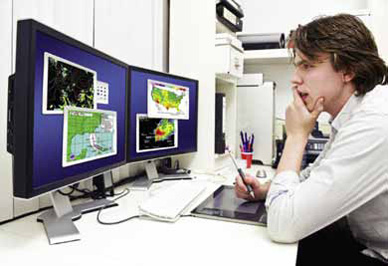Mathematical Models
A mathematical model is an equation that illustrates the way a process works. We can use a mathematical model to calculate how a country's population will grow over time. Engineering, statistics, and computer science are among the many fields that employ mathematical models in their work.
 Engineering students put their ideas into practice.
Engineering students put their ideas into practice.
The study of physics relies on mathematical models. Newton's 2nd Law of Motion can be expressed mathematically as F=ma (Force = mass x acceleration). You might experiment with this law by comparing the force needed to push an empty shopping cart compared to one that is full of groceries. The mass of the cart increases as you add more food. The amount of force necessary to move an empty shopping cart is much smaller than that needed to move a full one, and even more force is necessary to move a full cart quickly out of the way of an absentminded shopper coming your way!
NEWTON'S
2nd Law of Motion
F=ma
 Acceleration is quick with a light load. Less force is needed.
Acceleration is quick with a light load. Less force is needed.
 A large load makes for slower acceleration. Bringing the cart to a stop will be more difficult, too.
A large load makes for slower acceleration. Bringing the cart to a stop will be more difficult, too.
In most fields of study, different types of models are used to fill different needs. Weather models, for example, can be graphical, mathematical, or conceptual. A mathematical model can tell you what chance there is of rain on a given day. A graphical model can show approaching cold or warm fronts on a map and warn of dangerous storms on the way. A conceptual model can explain long-term weather trends, showing how current conditions might be drier or cooler than the average for an area.
 A dual monitor work station allows a meteorologist to take information from both graphical and conceptual weather models.
A dual monitor work station allows a meteorologist to take information from both graphical and conceptual weather models.
 Local forecasters give us an idea of how approaching weather fronts will affect our plans.
Local forecasters give us an idea of how approaching weather fronts will affect our plans.